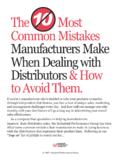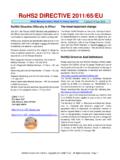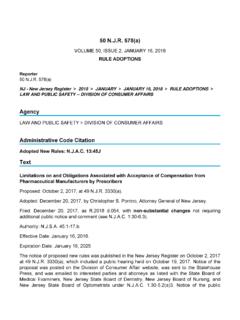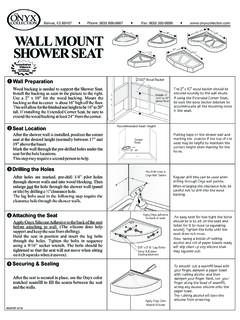Transcription of Not all manufacturers polishing compounds are ENKAY ...
1 MaterialBlack EmeryBrown TripoliWhite DiamondGreen StainlessRed RougeBlue All PurposeAcrylics Aluminum Brass Copper Gold Iron Nickel Pewter Platinum Sterling or Silver Plate Steel Nickel or Chrome Plate Brass or Copper Plate Stainless Steel Thermosetting Plastic (Baklite, Formica) Hard Rubber Horn Wood Introduction to PolishingIt s important to know what polishing means so that you not only understand what you re trying to achieve but also the processes involved.
2 When a material appears shiny you re actually seeing a reflection of light off the material. When a material appears dull, there are scratches or dirt preventing the light from directly reflecting off the surface. Dull material may just be dirty. Clean thoroughly, and if it s still dull then proceed to is similar to sanding. In order to make the mate-rial more reflective (smoother) you re simply removing the surface of the material to the depth of the deepest scratch. In order to do this you ll use a variety of tools and com-pounds, always working from coarse to fine (the same as if you were sanding a piece of wood).
3 These instructions take you through the basics and explain how and when to use the different tools and materials. The following steps can be followed for most reflective surfaces, including metals, plastics, rubber and even material is different. Before polishing a new surface it s a good idea to practice on a piece of scrap to familiar-ize yourself with the material and how it responds to wear protective gear when polishing , including safety goggles or face shield, dust mask, shop apron and gloves. You may also want to protect surfaces and tools with tape or padding to prevent accidental all manufacturers polishing compounds are the same.
4 These instructions and the accompanying compound chart are for use with ENKAY brand polishing compounds 1. Determine if the material you wish to polish needs to be sanded first. A good rule of thumb is if your fingernail can catch the edge of a scratch it will need to be sanded before it can be polished. Work your way up in grit from the coarsest applicable paper to the finest. Sand in a consistent motion without cross hatching follow the grain of the material, if visible, until there are no scratches visible and a satin finish is achieved (1000 grit wet dry is usually a good place to end up before polishing ).
5 Step 2. Start polishing by using any felt bobs, felt cones, or buffs except for the loose single stitched buff (the single stitched buff is the buffing wheel with 1 row of stitching around its center). The purpose of the different shaped buffs and bobs is that they will allow you to get into dif-ferent areas of the object being the buff you wish to start with into any standard electric drill or bench grinder and choose the coarsest applicable compound by consuslting the compound chart. (Find the material you wish to polish in the left hand column, then find the first marked column to the right for the correct compound .)
6 Step 3. Coat the buff or felt bob by lightly spinning it onto the chosen compound . Use the compounds sparingly you only need a small amount for them to work spin the coated buff or felt bob onto the surface to be polished. Best results are obtained at 3,000 RPM or less. Working at a higher rate heats the work surface and prevents the compound from working pressure works best let the coated buff do the work for you. You ll notice a residue coming off the material as you polish (metal should produce black soot). Continue polishing as needed, reapplying more compound if changing from one compound to another, remove the previous compound by raking the buff thoroughly.
7 Spin the buff against a sharp metal edge to remove the residue. For best results use a different buff for each 4. Repeat the process with the next finer compound as shown in the chart. Continue polishing until the surface appears shiny with no visible 5. To finish your project and achieve a mirror like finish use the finest applicable compound with the loose single stitched buff. Again use very light pressure and let the buff do the work for you. (It s not always necessary to go all the way to the finest applicable compound . Our White Diamond is sufficient in most cases.)
8 Step 6. Once work is completed you can (depending on the material) wash the material with warm soapy water to remove any excess buffing compound or residue, then dry with a soft cloth or chamois. Depending on the material you may want to protect your restored finish with a clear POLISHINGENKAY PRODUCTSPOB 140700 Howard Beach, NY 11414(718)272-5570 2006 ENKAY Products, tolikeaENKAY POLISHINGC ompound ChartCoarse FinePOLISHINGINSTRUCTIONS forENKAY ACCESSORIES







